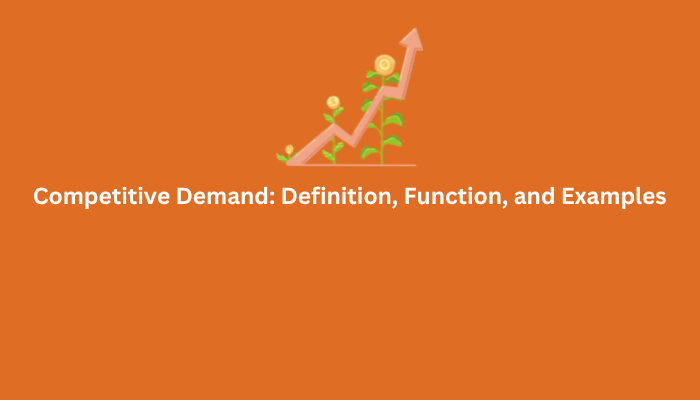What is Competitive Demand?
Competitive demand refers to the demand for a good or service when there are many available substitutes. It arises when alternative products or services are available to customers, allowing them to choose from multiple options.
Competitive demand enables consumers to switch between products based on factors like price, quality, and features. In essence, it signifies a dynamic market environment where buyers have the freedom to select from various offerings.
Importance of Competitive Demand
Competitive demand plays a crucial role in fostering a healthy, fair, and innovative market economy. By promoting market competition, it encourages firms to strive for excellence in terms of price, quality, and innovation.
Competition among suppliers benefits consumers by offering them a wide range of choices and ensuring fair pricing. Moreover, it leads to higher quality goods and services, spurs innovation, and enhances working conditions and wages for workers.
Function of Competitive Demand
One of the key functions of competitive demand is its influence on pricing strategies. Suppliers in competitive markets must consider competitor prices when setting their own, leading to price wars and product differentiation.
Market share allocation is also determined by competitive demand, with businesses competing to gain more of the market, which contributes to greater profits and growth. Additionally, competitive demand drives innovation by encouraging firms to develop new products and services to gain a competitive advantage.
How Competitive Demand Works
Competitive demand refers to an environment where there are multiple buyers and sellers for an identical product or service, but no individual can influence its price. Prices are determined through supply and demand dynamics in the market.
Suppliers respond to increased demand by increasing supply, which helps stabilize prices. However, intense competition may lead to price wars and challenges in maintaining profitability. Policymakers aim to strike a balance by encouraging competitive markets while safeguarding against unfair competition or market failures.
Characteristics of Good Competitive Demand
Good competitive demand is characterized by several factors that contribute to a vibrant and efficient market. These include low barriers to entry, many small suppliers, incentives for efficiency, responsiveness to changes, fair competition, sufficient profit margins, benefits for consumers, and stability.
When implemented effectively, competitive demand leads to a marketplace that benefits both consumers and suppliers, fostering economic efficiency, innovation, and prosperity.
Factors Affecting Competitive Demand
Various factors influence competitive demand, including the number of suppliers, barriers to entry, availability of substitutes, suppliers’ costs, demand, price sensitivity, regulations, technology, and globalization.
More suppliers, lower barriers to entry, more substitutes, lower costs, higher demand, higher price sensitivity, pro-competition policies, new technologies, and globalization contribute to greater competitive demand in a market. Policymakers and businesses must consider these factors to understand and address competitive dynamics effectively.
Example of Competitive Demand

An example of competitive demand can be observed in the meat market, where demand for beef and pork illustrates how consumers switch between substitutes based on price changes.
When the price of beef increases, consumers may opt for pork as a cheaper alternative, leading to a rise in demand for pork and a decrease in demand for beef. This phenomenon demonstrates how competitive demand influences market dynamics and pricing regulations.
Conclusion
Competitive demand is a fundamental concept in economics that shapes market behavior and outcomes. By fostering competition among suppliers and offering consumers a wide range of choices, competitive demand promotes efficiency, innovation, and consumer welfare.
Understanding its function, characteristics, and impact is essential for policymakers, businesses, and consumers alike to navigate and thrive in dynamic market environments.
Q&A Section:
What factors contribute to competitive demand?
Competitive demand is influenced by factors such as the number of suppliers, barriers to entry, availability of substitutes, costs, demand, regulations, technology, and globalization.
How does competitive demand affect consumers?
Competitive demand benefits consumers by offering them a wide range of choices, fair pricing, higher quality products, and innovation. It also enhances their purchasing power and contributes to economic growth.
What distinguishes good competitive demand from poor competitive demand?
Good competitive demand is characterized by factors such as low barriers to entry, many small suppliers, fair competition, responsiveness to changes, and benefits for consumers. Poor competitive demand lacks these qualities and may result in market inefficiencies and consumer detriment.
Resources
- methodologies-to-measure-market-competition-2021.pdf (oecd.org)
- Joint demand | Competitive and Composite demand | Learn economics (learn-economics.co.uk)
- Methodologies to measure market competition – OECD

I’m Mino, a forex trader with years of hands-on experience and a knack for market trends. My mission? To guide you through the complexities of forex trading and help you reach your financial aspirations. With personalized strategies and proven insights, I’ve empowered countless traders to navigate the markets confidently and achieve steady profits. Join me on the path to financial success in forex trading!
Don't Miss Pro Indicators and Trading Systems

